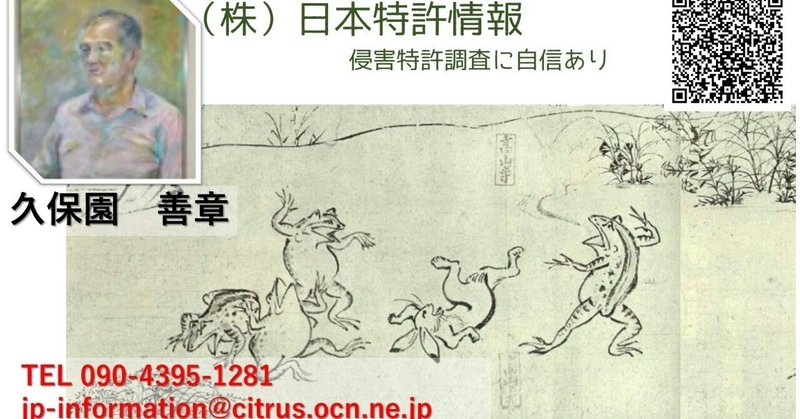
どうする特許庁! 目覚めよ審査官!! やっぱり、杜撰(ズサン)で、お粗末な「審査」(サーチ)による特許付与を、です。
知的財産高等裁判所により、「権利無効」とされたものの73件目です。
https://drive.google.com/file/d/13N4xtIUIUHVwj1lBSkrQi8RMfZp36don/view?usp=drive_link
特許権者である原告の株式会社コムスクエアは、自分が保有する特許第5,075,201号(「情報管理方法,情報管理装置及び情報管理プログラム)について、その特許の「有効性」を検証したか不明です。
「有効性」とは、自社の特許についての、例えば「無効資料調査」等を行うことで、たとえ利害関係者などの第三者からの「無効審判」を起こされても、自社の特許は盤石であると確信することです。
それにも拘らず、株式会社コムスクエアは、特許庁より与えられた特許を有効と信じて、被告であるTIS 株式会社を特許侵害している、と提訴しました。
先ず、東京地方裁判所は、「原告の請求は,主文掲記の限度で理由があるのでその範囲で認容し,その余は理由がないから棄却する。」とし、原告は一部勝訴しました。
しかしながら、知的財産高等裁判所は「本件発明は乙14発明と同一であるから,本件発明に係る特許は無効とされるべきものである。よって,1 審原告がこ特許権に基づき権利行使をすることは認められない。」とし、結局、控訴人は敗訴しました。
その根拠として、「乙14発明」(米国特許公開2005-0251445)を先行技術文献として挙げています。
この文献は、特許庁の審査段階では見つけることが出来なかった文献です。
審査官は自ら検索論式を作り、先行技術文献を3件探してきましたが、この中には上記の米国特許公開(米国特許公開2005-0251445)は含まれていません。
その後、出願人より「手続補正書」が出されて、結局、審査官は「登録査定」をしました。
更に、登録後の経緯です。上記の通り、原告が東京地方裁判所に提訴して一部勝訴しましたが、その後、知的財産高等裁判所で敗訴しました。
本件の根本原因は、特許庁段階で、知的財産高等裁判所で提示された「乙14発明」(米国特許公開2005-0251445)を探すことが出来なかったことに問題があると考えます。
特許庁の審査官による「サーチ」は、その対象とするものはほとんどが日本の特許文献のようです。
調査対象を外国特許にまで広げたのは、ごく最近になってからです。
特許庁の審査官による、不十分な「サーチ」に基づいての、特許付与は許されません。
「行政」(特許庁)としては、「司法」(裁判所)により誤りを指摘されたことを謙虚に反省し、その誤りを正すことを心掛けるべきです。
特に、審査官が登録調査機関の検索者を指導して作らせている、又は自らが作成していると思われる「検索論理式」の作成を、根本的に改革すべきです。
ここで、本件特許公開の「出願情報」のうち「FI」と「Fターム」を、本エクセル資料の2シート目以降に挙げておきました。
( Google Translation )
What will the patent office do! Wake up Judge! !
After all, it is a sloppy and poor "examination" (search) to grant a patent.
This is the 73rd case in which the Intellectual Property High Court has determined that the rights are invalid.
The plaintiff Comsquare Inc., the patentee, verified the "validity" of the patent No. 5,075,201 ("Information management method, information management device, and information management program)" held by itself.
I don't know if it did.
"Validity" means that even if a third party such as an interested party raises an "invalidation trial" by conducting, for example, an "invalid material investigation" for the company's patent, the company's patent is It is to be convinced that it is rock solid.
Despite this, Comsquare Inc. believed that the patent granted by the Patent Office was valid, and sued TIS Inc., the defendant, for infringement.
First of all, the Tokyo District Court said, ``The plaintiff's claim has reasons within the scope of the main text, so it is accepted to that extent, and the rest is dismissed because there are no reasons.''
The plaintiff partially won the lawsuit.
However, the Intellectual Property High Court said, ``Since the invention in question is the same as Invention No. 14, the patent pertaining to the invention in question should be invalidated.
It is not permitted to do so." In the end, the appellant lost the case.
As a basis for this, "Otsu No. 14 Invention" (U.S. Patent Publication No. 2005-0251445) is cited as a prior art document.
This document could not be found at the examination stage of the Patent Office.
The examiner created his own search formula and searched for three prior art documents, none of which included the aforementioned US patent publication (US Patent Publication 2005-0251445).
After that, the applicant issued a "Written Amendment", and in the end, the examiner made a "decision of registration".
In addition, it is the history after registration.
As mentioned above, the plaintiff filed a lawsuit at the Tokyo District Court and partially won, but later lost the case at the Intellectual Property High Court.
We believe that the root cause of this case is that the Patent Office was unable to find the "Otsu 14 Invention" (US Patent Publication No. 2005-0251445) presented at the Intellectual Property High Court.
Most of the "searches" by patent office examiners seem to target Japanese patent documents.
Only recently has it expanded its search to include foreign patents.
A patent will not be granted based on an inadequate "search" by a patent office examiner.
As the “administration” (the Patent Office), we should humbly reflect on the fact that the “judicial” (the court) pointed out the error, and should try to correct the error.
In particular, we should fundamentally reform the creation of "search logic formulas" that are thought to be created by examiners under the guidance of searchers of registered search organizations, or created by themselves.
Here, "FI" and "F term" in the "application information" of this patent publication are listed from the second sheet onwards of this Excel document.
(Google 翻译)
专利局会做什么! 法官醒醒吧! !
毕竟,授予专利是一项草率且糟糕的“审查”(检索)。
这是知识产权高等法院判定该权利无效的第73起案件。
专利权人原告Comsquare Inc.对其所持有的第5,075,201号专利(《信息管理方法、信息管理装置、信息管理程序)》的“有效性”进行了验证,不知道是否有效。
“有效”是指即使利害关系人等第三方通过对公司专利进行“无效材料调查”等方式提出“无效审判”,该公司的专利仍应被确信是坚如磐石。
尽管如此,Comsquare Inc.仍认为专利局授予的专利有效,并起诉被告TIS Inc.侵权。
首先,东京地方法院表示,“原告的主张在正文范围内有理由,因此在此范围内予以接受,其余部分因没有理由而驳回。"
原告部分胜诉诉讼。
然而,知识产权高等法院表示,“由于涉案发明与第14号发明相同,因此涉案发明的专利应该被宣告无效。
不允许这样做。”
最后,上诉人败诉。
作为其基础,引用了“大津No.14发明”(美国专利公开No.2005-0251445)作为现有技术文献。
该文件在专利局审查阶段未能找到。
审查员创建了自己的检索公式并检索了三篇现有技术文献,其中没有一篇包含上述美国专利公开(美国专利公开2005-0251445)。
之后,申请人出具了“书面修改意见”,最终审查员做出了“注册决定”。
另外,就是注册后的历史记录。
如上所述,原告向东京地方法院提起诉讼并部分胜诉,但后来在知识产权高等法院败诉。
我们认为,本案的根本原因是专利局无法找到向知识产权高等法院提交的“大津第14号发明”(美国专利公开号2005-0251445)。
专利局审查员的大多数“检索”似乎都针对日本专利文献。
直到最近,它才将搜索范围扩大到包括外国专利。
由于专利局审查员的“检索”不充分,不会授予专利。 作为“行政部门”(专利局),我们应该虚心反思“司法部门”(法院)指出的错误,并努力纠正错误。
特别是,我们应该从根本上改革“检索逻辑公式”的创建,这些公式被认为是由审查员在注册检索组织检索员的指导下创建的,或者是他们自己创建的。
这里,该专利公开的“申请信息”中的“FI”和“F术语”从该Excel文档的第二页开始列出。
この記事が気に入ったらサポートをしてみませんか?
